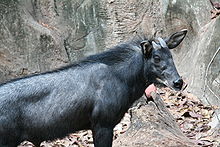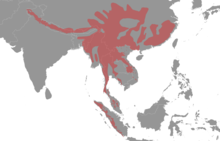Mainland serow
| Mainland serow | |
|---|---|

| |
| Scientific classification | |
| Domain: | Eukaryota |
| Kingdom: | Animalia |
| Phylum: | Chordata |
| Class: | Mammalia |
| Order: | Artiodactyla |
| Family: | Bovidae |
| Subfamily: | Caprinae |
| Genus: | Capricornis |
| Species: | C. sumatraensis[1]
|
| Binomial name | |
| Capricornis sumatraensis[1] (Bechstein, 1799)
| |

| |
| Synonyms | |
| |
The mainland serow (Capricornis sumatraensis) is a species of serow native to the Himalayas, Southeast Asia and China.[3][1]
The mainland serow is related closely to the red serow.[4]
Taxonomy
In 1831,
Teeth from C. sumatraensis were found in a dig from Khok Sung, estimated to originate from the Middle Pleistocene.[8]
Characteristics
The mainland serow possesses guard hairs on its coat that are bristly or coarse and cover the layer of fur closest to its skin to varying degrees. The animal has a mane that runs from the horns to the middle of the dorsal aspect of the animal between the scapulae covering the skin. The horns are only characteristic of the males and are light-colored, approximately six inches in length, and curve slightly towards the animal's back. The mainland serow, both male and female, is around three feet high at the shoulder, and typically weighs around 200 lb (91 kg).[9][10]
Distribution and habitat
The Himalayan serow inhabits hilly forests above an elevation of 300 m (980 ft), but descends to 100 m (330 ft) in winter.[11] It prefers elevations of 2,500–3,500 m (8,200–11,500 ft) in the Himalayas.[12]
The mainland serow is found in central and southern China, Vietnam, Cambodia, Laos, Myanmar, Thailand, and in the Indonesian island of Sumatra. Its distribution follows forested mountain ranges.[13][14]
The mainland serow inhabits steep, rugged hills up to an elevation of 4,500 m (14,800 ft). It prefers rocky terrain but is also found in forests and flat areas. It is able to swim to small offshore islands. This species has a moderate level of tolerance to human disturbance, and could persist well in habitat fragments and secondary forests, though avoiding farmlands.
Behaviour and ecology
The mainland serow is territorial and lives alone or in small groups.[15] Females give birth to a single young after a gestation period of about eight months.[16]
Conservation
The mainland serow is protected under
References
- ^ S2CID 155777271.
- PMID 27667928.)
{{cite journal}}: CS1 maint: multiple names: authors list (link - ^ . Retrieved 16 January 2022.
- ^ "Chinese Serow". Ecology Asia. Archived from the original on 2 September 2022.
- ^ Hodgson, B.H. (1831). "On the Bubaline Antelope. (Nobis.)". Gleanings in Science. 3 (April): 122–123.
- ^ Hodgson, B.H. (1831). "Contributions in Natural History". Gleanings in Science. 3 (October): 320–324.
- ^ Ogilby, W. (1836). "On the generic characters of Ruminants". Proceedings of the Zoological Society of London. 8: 131–140.
- PMID 27667928.
- ^ "serow | mammal | Britannica". www.britannica.com. Retrieved 2022-09-02.
- ^ Cunningham, Stephanie. "Capricornis sumatraensis (Sumatran serow)". Animal Diversity Web. Retrieved 2022-09-02.
- ^ Choudhury, A. (2003). "Status of serow (Capricornis sumatraensis) in Assam" (PDF). Tigerpaper. 30 (2): 1–2.
- ^ Aryal, A. (2009). "Habitat ecology of Himalayan serow (Capricornis sumatraensis ssp. thar) in Annapurna Conservation Area of Nepal" (PDF). Tigerpaper. 34 (4): 12–20.
- ^ "Observations". iNaturalist. Retrieved 2022-09-02.
- ISSN 1000-1050.
- PMID 32948037.
- ^ "Sumatran Serow". Encyclopaedia of Life. n.d. Retrieved November 4, 2022.

